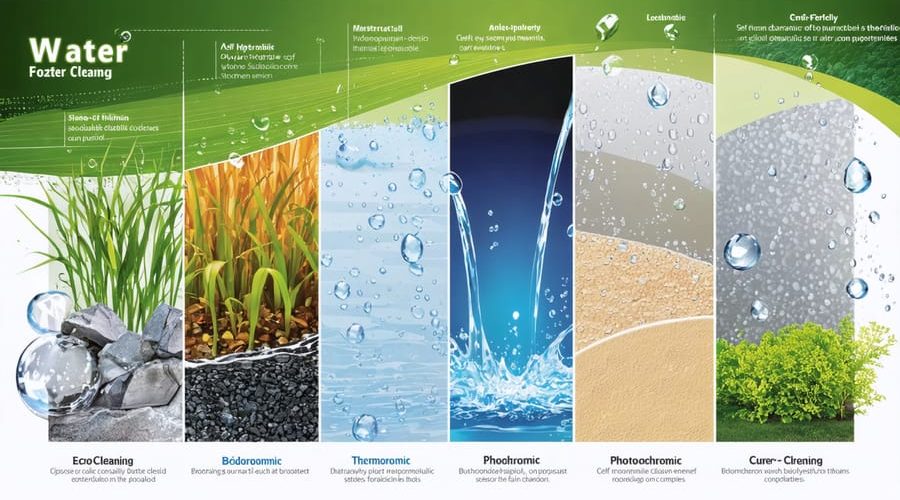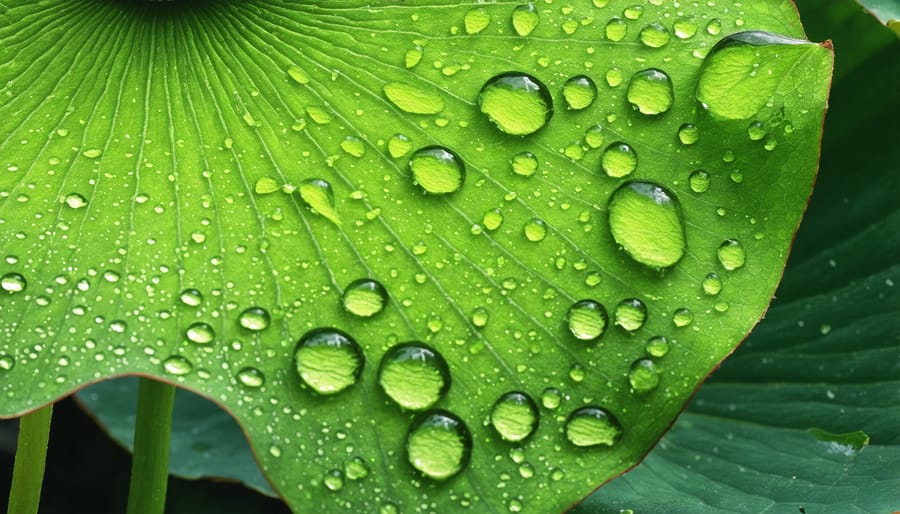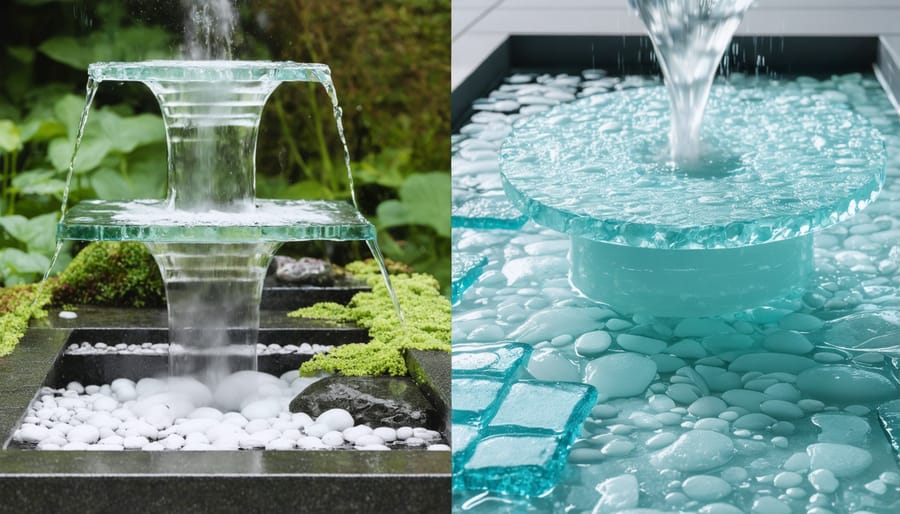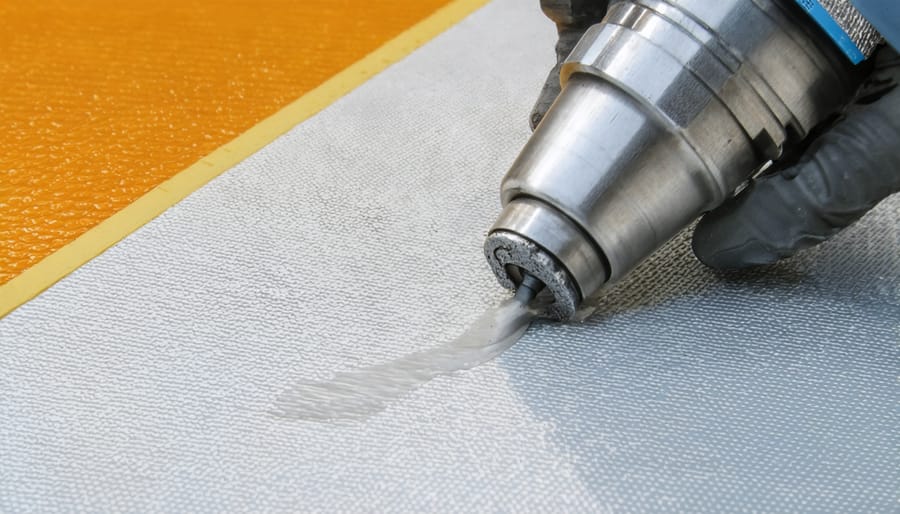
These Game-Changing Materials Are Revolutionizing Water Feature Design
Material innovations are revolutionizing how we interact with our everyday environment, from the water features in our gardens to the buildings that shape our cities. Recent breakthroughs in smart materials and sustainable technologies have opened up exciting possibilities for both DIY enthusiasts and professional designers. These new materials aren’t just about looking good – they’re helping us create more efficient, environmentally friendly, and longer-lasting solutions for our outdoor spaces.
From self-cleaning surfaces that keep water features pristine to bio-based composites that mimic natural stone at a fraction of the weight, today’s material innovations are making it easier than ever to maintain beautiful water features while reducing environmental impact. Advanced polymer blends now offer the durability of traditional materials with enhanced flexibility and weather resistance, while new nano-coatings provide unprecedented protection against algae and mineral buildup.
Whether you’re planning a small fountain or a large pond installation, understanding these material breakthroughs can help you make smarter choices for your outdoor projects. Let’s explore how these innovations are transforming the way we design and maintain water features.
Smart Materials That Adapt to Your Water Feature
Self-Cleaning Surfaces
One of the most exciting developments in water feature materials is the emergence of self-cleaning surfaces. These innovative coatings make it easier than ever to maintain crystal clear water with minimal effort. Using advanced hydrophobic technology, these surfaces actually repel water and prevent algae, mineral deposits, and other debris from sticking to your water feature’s surfaces.
The secret lies in microscopic patterns inspired by nature, like the lotus leaf effect, where water droplets simply roll off the surface, taking dirt and grime with them. These coatings can be applied to various materials, from stone and concrete to metal and glass, creating a protective barrier that works around the clock.
Some newer nano-materials even incorporate titanium dioxide, which becomes “activated” by sunlight to break down organic matter. This means your water feature essentially cleans itself during daylight hours, reducing the time you need to spend on maintenance. While these technologies might sound complicated, they’re actually quite simple to apply and can significantly extend the life of your water feature while keeping it looking pristine.

Color-Changing Elements
Imagine adding a touch of magic to your water feature with materials that transform before your eyes! Thermochromic elements change color in response to temperature variations, creating a dynamic display that shifts as the water temperature fluctuates throughout the day. These innovative materials can be incorporated into fountain bases, decorative tiles, or even pond liners, offering a subtle yet captivating color show.
Photochromic materials take this concept even further by responding to sunlight. When exposed to UV rays, these materials undergo a remarkable transformation, revealing hidden patterns or shifting between different hues. Picture stepping stones that develop intricate designs in the sunlight or fountain sculptures that display new colors during peak daylight hours.
Both technologies are completely safe for aquatic life and require no electricity or special maintenance. You can find these color-changing elements in various forms, from simple decorative pebbles to elaborate fountain features. For the DIY enthusiast, there are even special paints and coatings available that can add this fascinating property to existing water feature elements. The best part? These materials maintain their transformative properties for years, providing endless entertainment and visual interest to your outdoor space.
Eco-Friendly Material Breakthroughs
Biodegradable Components
The world of water feature materials is experiencing an exciting revolution with the introduction of plant-based alternatives to traditional plastics. These innovative biodegradable components are changing how we think about pond and fountain construction while helping protect our environment.
Leading the charge are materials made from corn starch, bamboo fibers, and mushroom-based composites. These natural alternatives break down harmlessly in the environment while offering impressive durability for water feature applications. For example, corn starch-based plastics are now being used to create pump housings and filter components that perform just as well as traditional materials but decompose naturally at the end of their life cycle.
Bamboo fiber composites are making waves in decorative elements, offering a natural wood-like appearance with superior water resistance. These materials can be molded into various shapes while maintaining their structural integrity, perfect for creating custom waterfall features and edge treatments.
Perhaps most exciting is the development of mycelium-based materials – created from mushroom roots – which can be grown into specific shapes and naturally waterproofed. These living materials are being used to create innovative bio-sculptures and water-resistant decorative elements that literally grow into their final form.
For DIY enthusiasts, these eco-friendly options are becoming increasingly available at local garden centers, making it easier than ever to create sustainable water features that look beautiful and help protect our planet.
Recycled Material Solutions
The world of water features is experiencing an exciting transformation through creative recycling initiatives. Innovative designers and DIY enthusiasts are discovering ingenious ways to repurpose everyday materials into stunning water feature elements. Old glass bottles, for instance, are being transformed into colorful waterfall walls that create mesmerizing light effects when water flows over them.
Recycled plastic has found new life in the form of durable fountain components and decorative elements. Many manufacturers now offer fountain bowls and spillways made from post-consumer plastic, which not only reduces environmental impact but also provides excellent weather resistance and longevity.
Reclaimed metal pieces, particularly copper and steel, are being reimagined as artistic water spouts and sculptural elements. Old industrial parts, from machinery gears to bicycle wheels, are finding second lives as unique water feature focal points. These items develop beautiful patinas over time, adding character to your water garden.
Even concrete rubble from demolition sites is being crushed and reformed into permeable pavers and decorative rock features. These materials provide excellent filtration properties while giving your water feature an authentic, aged appearance.
For the eco-conscious DIYer, salvaged bamboo and natural wood pieces can be hollowed out to create organic-looking spouts and channels. These materials blend seamlessly with natural landscapes and can be easily replaced when needed, making them both sustainable and practical choices for water features.

Enhanced Durability Materials
Weather-Resistant Innovations
Today’s water feature materials are pushing the boundaries of what’s possible in challenging environments. From scorching sun to freezing temperatures, new weather-resistant innovations are changing the game for outdoor water features.
One exciting development is UV-stabilized polymers, which maintain their integrity even after years of sun exposure. These materials resist fading, cracking, and brittleness, making them perfect for fountain components and decorative elements that sit in direct sunlight. For those in colder climates, impact-modified resins now offer exceptional durability against freeze-thaw cycles, preventing the dreaded winter damage that used to plague water features.
Nano-coated metals are another breakthrough, featuring microscopic protective layers that prevent corrosion and mineral buildup. These coatings are self-healing, meaning minor scratches automatically repair themselves, extending the life of pumps and fittings.
For exposed water feature parts, new composite materials combine the strength of traditional materials with modern weather resistance. These hybrids offer the classic look of stone or metal but withstand everything from acid rain to extreme temperature swings without deteriorating.
Manufacturers are also introducing smart materials that adapt to weather conditions. Temperature-responsive polymers can adjust their flexibility based on the climate, while hydrophobic surfaces actively repel water and prevent ice formation during winter months. These innovations mean less maintenance and longer-lasting water features for everyone.

Anti-Corrosion Developments
Recent breakthroughs in anti-corrosion technology have transformed how we protect our water features from the damaging effects of constant water exposure. One exciting development is the emergence of ceramic-based coatings that create an invisible shield against rust and deterioration. These coatings are perfect for protecting metal fountains and pond accessories, and they’re much easier to apply than traditional protective methods.
Nano-technology has also made its way into the world of water features. New materials infused with tiny particles create a self-healing surface that can repair minor scratches and damage on its own. This means less maintenance and longer-lasting equipment for your pond or fountain.
For those concerned about environmental impact, there are now plant-based protective coatings that offer excellent corrosion resistance without harmful chemicals. These green alternatives are particularly suitable for ponds with sensitive fish and aquatic plants.
Another game-changer is the development of composite materials that combine the strength of metal with the corrosion resistance of plastic. These hybrid materials are being used in pump housings and fountain components, offering the best of both worlds – durability and rust resistance.
For DIY enthusiasts, many of these new protective solutions come in easy-to-use formats like spray-on applications or brush-on coatings. This makes it simple to add years of life to your existing water feature equipment without professional help.
The exciting world of material innovations in water features continues to evolve at a remarkable pace, transforming how we build, maintain, and enjoy our outdoor water spaces. These advancements have not only made water features more accessible to the average homeowner but have also opened up new possibilities for creativity and sustainability.
From self-cleaning surfaces that reduce maintenance time to smart materials that adapt to weather conditions, these innovations are making water gardening more enjoyable and less demanding. The shift toward eco-friendly materials has particularly resonated with environmentally conscious enthusiasts, proving that beauty and sustainability can go hand in hand.
Looking ahead, the future of water feature materials seems incredibly promising. Researchers are developing even more sustainable options, including biodegradable components and materials that can harness solar energy more efficiently. We’re also seeing the emergence of “smart” materials that can change color or texture based on water temperature or quality, adding both functional and aesthetic value to water features.
For DIY enthusiasts and pond lovers, these innovations mean more options, better durability, and easier maintenance. As materials become more sophisticated yet user-friendly, creating stunning water features is becoming more achievable for hobbyists of all skill levels.
The next few years will likely bring even more exciting developments, from advanced filtration materials to revolutionary lighting solutions. Whether you’re a seasoned water gardener or just starting your journey, these material innovations are making it easier than ever to create and maintain the water feature of your dreams while being mindful of our environment.
